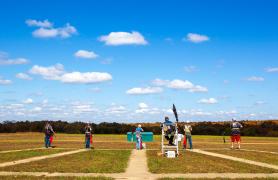
Missouri became the 24th state in the union on Aug. 10, 1821. We will celebrate that 200-year milestone — or bicentennial — this year.
As you might imagine, Missouri in 1821 looked much different than what you see today as you travel down highways, along rivers, and through cities and towns.
In seeking to understand this historical milestone, we can examine 200 years of Missouri’s wildlife and conservation history through the artwork of conservation pioneer and artist Charles W. Schwartz.
The Artist
Charles W. Schwartz (1914–1991) joined the Missouri Conservation Commission as a biologist in 1940. Along with his wife, Libby, Schwartz served as an artist and filmmaker for 41 years until his retirement in 1981. In 1965, Schwartz began work on a series of murals to pictorially tell the story of conservation from the state’s pre-settlement condition and early exploitation of resources, through the formation of the conservation commission to the present conservation movement. The series, consisting of eight separate murals, was completed in 1987, just in time for the 50th anniversary of the Missouri Department of Conservation.
Today, as you enter the lobby of the Commission Headquarters in Jefferson City, you are surrounded by his depiction of Missouri’s conservation story.
Pristine Missouri
In his first mural, Schwartz depicts wildlife species most associated with Missouri’s forests prior to European settlement. The mountain lion, whitetail deer, wild turkey, and ruffed grouse feature prominently in this mural. Historically, forests covered 30 million acres of Missouri’s Ozark hills and consisted of old growth pine, oak, and hickory trees. Bottomland forests followed streams and rivers and mixed with dense cane breaks. In other areas open woodlands and parklike savannas, consisting of large, dispersed trees with grass understory dominated the landscape. The river otter was found in abundance in Missouri rivers, where large fish swam in deep, clear water. Birds, like the colorful Carolina parakeet, were seen in Missouri skies. The now extinct bird formed large flocks, was often written about, and appears in early American artwork. A lone Native American man catching a catfish represents the early cultures who hunted, fished, and lived in a mostly unaltered natural landscape.
1700s
The second largest habitat in Missouri consisted of 15 million acres of prairies, and Schwartz chose this as the focus of his second mural. Ranging from tall grass prairies to sand prairies and loess hill prairies, Missouri was home to a diverse mix of native grasslands supporting a rich abundance of wildlife. The Wazhazhe (Osage) and the Niutachi (Missouria) both lived within Missouri’s prairie landscape. A man, perhaps from one of these cultures, is depicted plucking a blue-winged teal as he appears to be observing the abundance the land around him offers.
1800s
Schwartz’s third mural depicts the 1800s, the time that most negatively affected Missouri’s fish, forest, and wildlife resources, ultimately threatening to end them. With Missouri statehood on Aug. 10, 1821, the flow of westward expansion had begun. The western fur trade was centered in the metropolis of St. Louis, and historic trails, such as those to Santa Fe, Oregon, and California, brought settlers from all over the globe seeking wealth and a new beginning in the west. That influx would put a strain on both natural resources and native people. Over half of the forested lands in Missouri were cut to build railroads, which pushed west from cities that required lumber for new construction. Native prairies were plowed under for crops to feed expanding populations. This mural depicts men sawing lumber from the old growth shortleaf pine of the Ozarks and hacking railroad ties from oak logs. As the land was denuded of its towering forests, rain eroded the fragile thin soil, choking the once deep clear streams with gravel. Livestock were allowed to “free range,” competing with native wildlife for food on an already compromised landscape. All these practices paved the way for what would come next, the wholesale exploitation of Missouri’s wildlife and wild lands.
Exploitation
Once Missouri’s natural landscape had been degraded and habitats destroyed, wildlife and fish species could not resist the overwhelming exploitation. Citizens had viewed these resources as inexhaustible — there would certainly be enough, they thought. Wildlife was harvested without regard to season or bag limit. Missourians shopping at meat markets in larger cities could have their pick of black bear, wild turkey, whitetail deer, rabbits, and almost every type of fowl imaginable. The commercialization didn’t just encompass the overharvest of fish and wildlife for food. It included the taking of birds for the latest fashions, including feathers for hats and clothing. In his fourth mural, Schwartz represents this time with the extermination and eventual extinction of the passenger pigeon, the netting of fish from a river, a woman shopping for wild birds in a meat market, and the hunting of a whitetail doe with a fawn. There had to be changes — and soon there would be.
1930s
For Missourians, the 20th century had dawned much like the old century had gone out. Many wildlife species had been extirpated from the landscape and the few that remained were in dwindling numbers in fragmented habitats. The native elk and bison, which had sustained Missouri’s early native people, were now gone. By the mid-1920s, the whitetail deer population included just a few hundred animals and the wild turkey, once considered so numerous that settlers didn’t bother to keep domesticated turkeys, were reduced to a few thousand birds in the deep Ozark hills. The time was ripe for a change and nationally that began with a new push for conservation reforms and regulations. In Missouri, it began with the formation of a citizen’s organization known today as the Conservation Federation of Missouri. The group consisted of those interested in the non-political management of the fish, forest, and wildlife resources of the state. Through the initiative petition process and collection of signatures, they were successful in placing Amendment 4 on the 1935 ballot, calling for creation of a four-member conservation commission responsible for the management, protection, and restoration of these resources. The ballot measure passed overwhelmingly with over 71 percent support statewide, and in 1937, a new agency was created. Schwartz captures this pivotal time in his fifth mural by showing those activities that Missourians were engaged in including hunting, fishing, and trapping. Game species, including bobwhite quail and furbearers like the coyote, are present. A raccoon is perched atop a fence post, where a poster urges support for Amendment 4. The time had come for conservation-minded Missourians to make a difference.
Restoration
The fledgling conservation commission immediately went to work building a science-based wildlife management agency. Their goal — bring back lost or imperiled wildlife. Their focus in the early years was on restoration of the whitetail deer, wild turkey, and the forests that would sustain them. To do that, citizens had to be enlisted to support the commission’s restoration efforts. Regulations were enacted, forest fires suppressed, and conservation education brought to every community. Schwartz represents this period in his sixth mural with depictions of the translocation of wild turkey and whitetail deer. Simply put, biologists captured animals to relocate them to new areas of suitable habitat. Included as well is a nod to early forest fire prevention efforts utilizing forest look-out towers dotting the Ozark landscape. A logger cutting an oak tree represents the return of sustainable forestry practices and the forest products industry. Finally, the deer hunter is represented with the fruits of a successful hunt, a large buck. Many advances were made during the period of restoration in the 1940s and 1950s. Conservation was working.
Management
The 1960s were marked with conservation success across Missouri. Between 1944 and 1962, the conservation commission assisted farmers with more than 138,484 ponds and stocked 52,570 lakes and ponds. By 1966, the commission had acquired 23 upland wildlife areas, 180,000 acres of forests, and 42 river accesses for Missourians to connect with their resources.
In his seventh mural, Schwartz emphasizes waterfowl, including the Canada goose, a migratory population Missouri shares with many other states and Canada. Missouri’s cold-water hatchery program is represented with the addition of the trout angler. Alongside the angler, Schwartz placed the first trout stamp, which was introduced in 1969, an effort to make the stocking program more self-supporting. To the right side of the mural a young boy catches a bluegill from a farm pond, fisheries biologists use electro-sampling to study fish species, and a conservation agent pulls a catfish from an illegal fish trap. The 1960s were a time of great progress in conservation management and protection, but in 1967 one thing was evident to newly hired Director Carl Noren — the need for secure funding into the future.
More and more citizens were enjoying the now plentiful resources earlier generations worked so hard to reestablish. This increased use placed a greater burden on existing budgets, which had traditionally supported game species and had come from the sale of hunting and fishing permits. Funding had been inadequate for many other species and a new way forward would have to be developed if programs and services were to remain effective. Enter the Design for Conservation campaign.
1976
Schwartz’s final mural captures the essence and true spirit of conservation, educating the next generation and passing along an appreciation of the natural world. In 1975, Missourians voted to take a giant leap in conservation management of the state’s resources. The proposal was called Design for Conservation, but most people refer to it as the one-eighth of 1 percent conservation sales tax. The basic math is that for every $8 spent on taxable items, one penny is set aside for conservation of the fish, forest, and wildlife resources of the state. The Design for Conservation was passed by Missouri voters and went into effect in 1976. Much of what the plan brought to Missourians included conservation education and interpretive centers as well as the scientific research and protection for many nongame species, such as the great blue heron, bald eagle, pileated woodpecker, bats, and reptiles. In the center of the mural, Schwartz includes an adult helping children discover nature, a primary mission of the agency from the very beginning in 1937. Finally, he includes a well-deserved recognition of his wife and partner of 53 years, Libby Schwartz. Libby is depicted working on her box turtle research that she carried on from the couple’s home near Jefferson City. Next to Libby is one of several family pets, a black Labrador, who assisted in finding the reptiles.
The Present
Today, Missourians are just as dedicated as their ancestors to protecting and preserving our state’s fish, forests, and wildlife. Whether fishing one of the state’s premier reservoirs, hunting for that elusive wild turkey, or kayaking down a clear, fast Ozark stream, Missourians continue to build upon a long and rich tradition of the wise use of our resources.
Famed conservationist Aldo Leopold once observed about Missouri’s conservation tradition: “Conservation at bottom rests on the conviction that there are things in this world more important than dollar signs and ciphers. Many of these other things attach to the land, and to the life that’s on it and in it. People who know these things are growing scarcer, but less so in Missouri than elsewhere. This is why conservation is possible here.”
These Charles W. Schwartz conservation murals, as well as other decade murals, may be viewed during normal business hours, Monday through Friday from 8 a.m. to 5 p.m. at the Missouri Conservation Commission Headquarters in Jefferson City.


















Also In This Issue

Snorkeling offers unique view of stream life

A gateway to firearms safety, outdoor skills, and self-confidence
And More...
This Issue's Staff
Stephanie Thurber
EDITOR
Angie Daly Morfeld
ASSOCIATE EDITOR
Larry Archer
PHOTOGRAPHY EDITOR
Cliff White
STAFF WRITERS
Bonnie Chasteen
Kristie Hilgedick
Joe Jerek
DESIGNERS
Shawn Carey
Marci Porter
PHOTOGRAPHERS
Noppadol Paothong
David Stonner
CIRCULATION MANAGER
Laura Scheuler






















